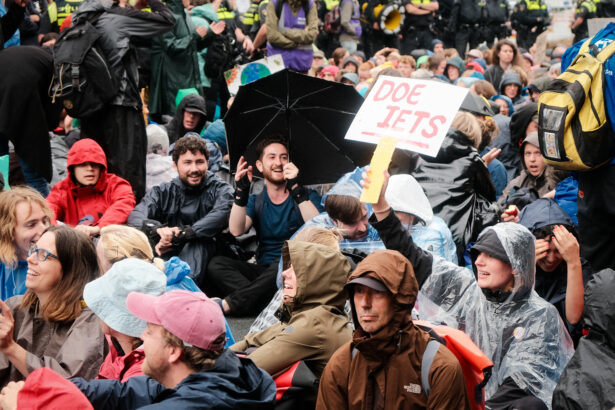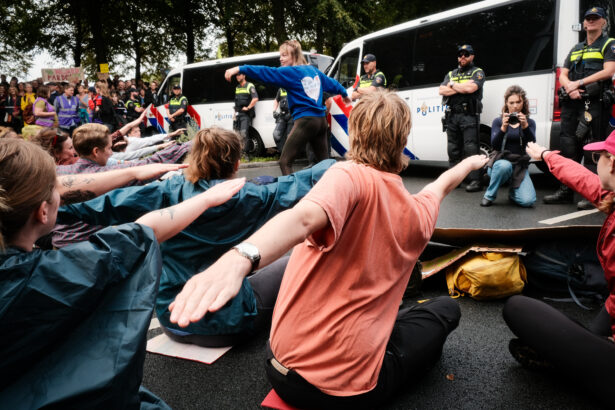Success in climate activism can take a lot of forms, and relatively few of them are glamorous. The change we work for might be too abstract to measure, or our role in it might be unclear. Perhaps, in difficult conditions, success might mean no more than keeping your head above the water.
Still, there are times when success can actually be joyful, epic and infectious, as in the case of the recent blockades on the Dutch capital’s A12 highway.
The shortest version of this story is that a multi-year campaign of disruption induced the Dutch Parliament to move, on Oct. 10, towards a phasing-out of fossil fuel subsidies: a truly remarkable moment and concession. (For those who like success as numbers: The campaign involved over 9,000 arrests, and the subsidies in question are as much as $50.9 billion a year.)
But success can also be a process. To focus just on the outcomes above would be to miss something much more important. Over the course of a year, Extinction Rebellion Netherlands, or XR NL, and its allies have cultivated what can only accurately be described as magic: a swirling cascade of positive energy, compelling narratives and movement growth. One organizer I spoke to described it as a “societal tipping point.”

It’s potentially bigger than that: Much like XR UK’s seminal Pink Boat moment in April 2019, XR NL has inspired emulations abroad.
By Nov. 25, activists in Berlin were already launching their second effort at a recreation of the A12 blockade. Another German effort, from a different coalition, is planned for early December. Activists in Belgium and Austria have similarly been communicating closely with their Dutch colleagues, explicitly trying to replicate what happened in The Hague — and A12-fever may well spread further yet.
Despite the chilling results of the recent Dutch election and the continued heartbreaking events in Palestine-Israel overshadowing what would otherwise have been its triumph, the A12 blockade may well go down as a quintessential climate campaign. So what happened?
False start
The blockade was a long time in the making. In 2020, XR NL announced a new strategy to oppose government subsidies of the fossil fuel industry. This was a niche issue at the time, though a report published that year revealed these subsidies ran to $5.4 billion per year.
Lockdown prevented any immediate action in service of this new direction. But XR NL spokesperson Chris Julien recounted, “we hit the ground running after COVID. We got our local groups set up, we had a lot of vibrancy and growth — by 2022 we were able to run 350 actions across the country.”
Most of these actions were local, but there was also a small group trying something more ambitious: blocking a stretch of highway in The Hague.
The first attempt was actually in October 2021, as part of a larger wave of actions in the Dutch capital, and it went quite badly. In a scene that many will no doubt find drearily familiar, police intercepted the blockade — comprising just 25 people — before it even started, arresting 21 (including two journalists) and charging four with suspended prison sentences.
Fury road
On July 6, 2022 they were back with similarly tiny numbers, but a bit more preparation. This time they made it onto the road, and after a short interval were arrested.
Despite little obvious impact, two months later the group was back again. And then again the next month, and the next. By November 2022 the numbers were a bit bigger, allowing the protest to occupy a more commanding, dual-lane position on the road — from which 150 people were arrested.
At this point, faced with a persistent and increasing inconvenience, the Dutch police apparently decided that enough was enough. In the days before the January 2023 blockade, police held dawn raids at the homes of six suspected organizers, and barred them from the A12 for three months; elsewhere, an activist received the same treatment simply for advertising the blockade on Twitter.
If the intention of this crackdown was to send a message, then it worked — but not as planned. The arrests sparked public outrage at this clampdown on the right to protest, with nearly 40 civil society organizations — among them Greenpeace, Amnesty International and Oxfam — declaring not only their opposition to the arrests, but their intention to send representatives in support of the impending blockade.

Even in video, you can tell there’s something profoundly different about the Jan. 28 blockade. And it was here — with unprecedented turnout and morale — that the special properties of this patch of the A12 became apparent.
Although initial blockades had targeted access roads, the larger numbers in January allowed XR NL to occupy an amphitheater-like half-tunnel (their presence can even be seen on Google’s Street View). Those who were not ready to risk arrest offered scrutiny, supplies and their support from the road’s upper levels. “I’ve never felt so much a Champions League soccer player,” Julien said. And not unlike a Champions League match, a significant fraction of the country was now watching this colorful, infectious spectacle — and some were wishing they could be there.
The big time
The next two blockades extended what now had become a path of literally exponential growth in numbers: from 3,000 on March 11 to 7,000 on May 27. On these occasions police began their use of “sprinkle” water cannons (which aim to disperse crowds with the threat and reality of hypothermia) and, perhaps more astutely, prevented the crowds from reaching the half-tunnel occupied in January.
But the cat was out of the bag: The A12 blockade had become a national story. The public generally opposed the blockade, but with notable nuance. “Of course we got slammed by the right-wing press, and the rest were generally hostile” Julien explained, “but not in this slanderous way you get in the U.K.”
He thinks an understated spokesperson strategy helped: “Our representatives were very average, ordinary people who our opponents found it hard to criticize all that much.” Another win on this front was a network of 400 green churches coming out in support of the May blockade.

At the same time, and in contrast to the blockade itself, the core demand was gaining popular traction — not least when an independent study suggested in March that the amount of subsidies might actually be far higher than they first thought — potentially three times as much ($19 billion).
Riding such a wave, the May 27 blockade was a tour de force, generating international news coverage, viral vibes and over 1,500 arrests (among them several Dutch celebrities, including “Game of Thrones” actor Carice van Houten). Perhaps it also caused some consternation among organizers: How do you escalate from that?
Showdown
On June 20, those organizers took the daring gamble of pledging to ramp up the blockades from monthly to daily, relenting only when or if the Dutch government took action on what had by this point become “the” subsidy problem.
As both sides prepared for this new chapter, the sensational news emerged that, under scrutiny from the campaign, the government had revised its estimation of the subsidies to as much as $50.9 billion a year. “This was a huge win for us,” Julien said. “It was a big validation of our ‘tell the truth’ narrative.” On the eve of the blockades, even the police unions called on politicians to ‘listen to their citizens.’”
On Sept. 9, the blockade began with numbers estimated between 10,000 and 25,000. Of these, 2,400 were arrested. But sustaining these numbers indefinitely was not the goal. On weekdays, XR kept the blockade ticking with a smaller core — never less than 200 according to Julien — and crucially, with hundreds more attending in support.
“We kind of accidentally discovered the supporter mode,” Julien explained, whereby anyone not willing or able to face arrest was encouraged to attend in active logistical and moral support. He thinks this system did a lot to sustain the campaign’s distinctive positive energy — but also provided an escalator for people to get progressively more inspired and involved.
It’s worth noting that the process of arrest itself was quite different here from most countries in the Anglosphere. Police would haul protesters away from the scene, but judges made clear there was nothing meaningful to charge them with (one commenting “the arrest is punishment enough”). Julien said the routine was “we would start the protest at 12, get arrested pretty quickly, and be released again by 2.”

This merciless routine drew on for days and then weeks, with huge surges on the weekends. The arrests could indeed be punishing. Police ramped up the pressure with much stronger water cannons courtesy of Belgian and German police, causing severe bruising, in an escalation ultimately deemed excessive by Dutch judges. Another dubious innovation was the police’s adoption of wheeled stretchers to speed up the process of arrest.
I expected to discover more scenes of hostility from members of the public, but found virtually nothing — something Julien puts down mostly to the supportive crowds (and which contrasts with some British experiences).
Much as police were escalating their violence, XR NL ramped up its positive energy. XR musicians, a group which had emerged spontaneously from earlier blockades, staged an epic 180-person performance of “Dies Irae” for the opening blockade, and ran a surreal air-performance the following week when police confiscated instruments.
The blockaders also found their own German support, in the form of a 100-person delegation from the German direct action group Last Generation, or LG. “They were really wowed by the vibe,” Julien said. They were the most prominent faces in the thriving scene of European visitors, many of whom took back reverential news of the success to their home countries.
Despite the public expectation that the daily blockades would last less than a week, nearly a month in the campaign was showing no signs of relent. And then, on Oct. 5, the Dutch Parliament announced that it was scheduling a motion to lay the groundwork for a phase-out of subsidies. XR announced it would suspend further blockades until the verdict. On Oct. 10 the motion passed.
A lot has changed in international and domestic politics since then — but XR NL still has plenty of momentum, having swelled its ranks enormously during the blockades. Julien says they’re watching closely to see how their “provisional breakthrough” on subsidies unfolds. In the meantime, plans include a mass action opposing North Sea oil and gas expansion, and at the end of the year a campaign against ING’s funding of fossil projects will attempt a blockade of the A10 (essentially Amsterdam’s equivalent of the A12).
Berlin and beyond
XR NL is not alone in seeking to recreate its A12 miracle. On Oct. 28, LG mounted an A12-styled blockade on the major 17 June Street in Berlin, and repeated it on Nov. 25.
The first blockade in October — which featured a delegation from XR NL among the 1,000-strong crowd, and a new demand of ending fossil subsidies — went down much like other LG actions. A police ban prompted 160 of those present to defiantly glue themselves to the road, eventually being lugged away by characteristically unscrupulous German police.
November’s blockade — slightly bigger than the previous month’s, and attended by two allied groups — landed a different tone. Although the road was occupied again, this time police made no arrests, declaring that the law had not been broken. The day concluded with a feast and a party. They’ll be back on Feb. 3.
Previous Coverage
 What’s next for Extinction Rebellion after a disappointing success?
What’s next for Extinction Rebellion after a disappointing success?Incredibly, this is just one of Berlin’s large-scale efforts at cracking the A12 formula. The other is a coalition convened by Extinction Rebellion Germany (and including the tireless LG) to occupy the Elsenbrücke, one of the city’s bridges on Dec. 9. It is, again, self-consciously styled around the A12 success. The demand is ending fossil fuel subsidies, with a focus on numbers and atmosphere and a concerted attempt to get engagement from a wide array of groups.
Amelie Meyer, a member of XR Germany’s press team, added that “whereas previously when we did mass actions in Berlin, it was one special demand for a week and then it was over — we want to keep working at this demand for longer.” There’s no sequel to Dec. 9 in the calendar just yet, but this is likely the beginning of another sustained effort.
It’s not just Germany. Across the border, Marina Hagen-Canaval — a spokesperson for Last Generation Austria — describes her group’s reaction: “Once we saw that the blockade had been going on for 20 days we were like ‘Oh my god, this is groundbreaking.’ After they won we waited a few days, then got in touch.”
They’ve since been in close contact, and LG Austria is “in the very early days” of an A12 emulation. “We’re mainly doing networking for now, and looking for the perfect spot,” Hagen-Canaval explained.
Extinction Rebellion in Belgium has also moved in this direction, with an A12-esque action in September railing against fossil fuel subsidies. It’s striking to see, over and over, how in the space of a few weeks entire national movements have been inspired to re-imagine their strategies along these lines.
The A factor
The big question for organizers and aspiring A12 exporters is how far the original campaign’s success hinged on specific local properties or generalizable tactics. “We’re always talking about that,” Hagen-Canaval said. Meyer agreed: “We’ve analyzed that a lot.”
Is this model viable, for example, in countries with police and judiciaries more inclined to punish peaceful protest? Similar arguments might be made about the Netherlands’ comparatively functional political and media systems, and its robust civil society. There’s also the logistical factor of The Hague being easily accessed from the rest of the country, and wildcards like the dramatic revelations on the scale of Dutch subsidies.

Support Us
Please donate so that we can continue producing stories like this in the new year.
DonateIn terms of the tactics themselves, there’s wide consensus on some A12 staples (vibes, numbers, civil society, persistence, subsidies), but I’ve heard more varied interpretations of some elements. Hagen-Canaval attributes a lot of significance to an XR NL decision to designate a core team with a mandate for organizing the A12 actions, as a way of streamlining decisions.
Meyer, on the other hand, notes that the Dutch blockades were strikingly relaxed: “They don’t have that many roles, there wasn’t a debrief, there wasn’t food afterwards — it was more just ‘go there and enjoy yourself.’”
She added that “since Last Generation started sitting in the roads we’ve seen a lot more hostility from the public — they often have quite a negative image of climate activists.” Following some thought, she posits a careful hope that the Elsenbrücke blockade might redraw the idea of what a climate activist can be.
As COP 28 meets under a cloud of smog to hear its president deny the science of phasing out fossil fuels, and the latest U.N. estimate puts global warming on track for almost 3 degrees Celsius, it’s clear our world is at a crossroads. Maybe the A12 will take us toward something better.

Fantastic article easy to read and full of information which can be used by others. Thank you!
Great article, thanks for the extensive recap. With disappointing election results and XR being a movement that has always had waves of up- and downsurges, it is sometimes hard to see the societal wins that we’ve gotten.
We have to keep celebrating those wins to keep up morale – as duly noted by people like Srdja Popovic and George Lakey. Something progressive movements have been notoriously bad at the last decades.
Furthermore, I’d like to note for readers that there’s also good ripple-effects going on. At the same time as this wave, there have been networks of activists doing ground work in setting up organisations like Deep Canvassing NL (deepcanvassing.nl, doing door-to-door canvassing independent of parliamentary parties) and Netwerk Klimaat FNV (netwerkklimaatfnv.nl, organizing within NLs most progressive union), because direct actions in itself are not enough – there has to be a substantial *organizing* aspect in parallel in neighborhoods and workplaces, to keep drawing people to our side and broaden our base.
On a last note – in Germany there’s a very promising campaign, Wir fahren zusammen (wir-fahren-zusammen.de, We travel together) started by FFF and union ver.di. This one might merit a whole article on it’s own!
In solidarity,
Ismani, active with amongst others XR in NL